Have you driven by a road sign that proclaimed it mark the spot where a town once stood only to see nothing but wide open space? Ever wonder exactly what that town looked like or who were the people who decided to make this stop their home? Come along as we go in search of one of these long forgotten places.
Our journey begins in the Kamiah Valley. From here we will take Highway 162; up what is called Seven-Mile Grade. An interesting note, while doing research we found that from 1902-1908 there was a 7-Mile School. The building sat approximately one-half mile from the confluence of 7-Mile and Lawyers Creek. In the 1940-1950’s it was sold and move to private property. Teachers were Myrtle Miller, Beulah McCarty Wilson, Fannie Roberts, and Bessie Hammil.

Traveling on up the Camas Prairie ( named after the blue camas that grew here in abundance) we come to old the townsite of Winona. What the sign does not tell you is that Winona was originally named Lowe. In 1896 a Montana freighter by the name of Daniel M Day took up a homestead of approximately 160 acres on which he started constructing the town. A.P McBoyle came to Lowe and purchased an acre of ground from Day on which he promptly builds a business. This inspired Day to lay out four blocks into city lots. They were soon purchased and Mr. Day’s wheat field changed into a busy little town. In February of 1905, Lowe was dedicated to the use of the public.
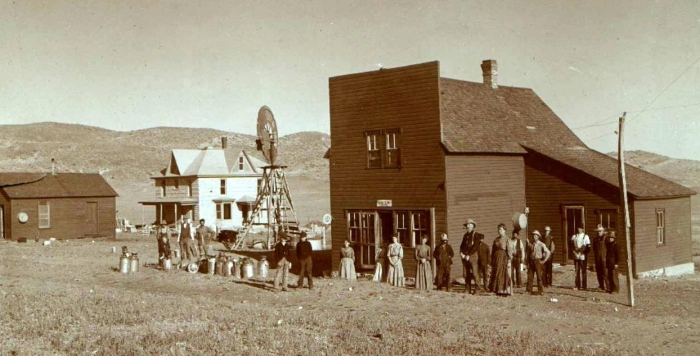

As the wheat farming increased on the Camas Prairie the need to get the grain to the railhead became of major concern. Mr. McBoyle gave much encouragement to the development of a tramway that could move the grain off the prairie to the river region. Kooskia became the point for this as they had a flour mill near the train depot. (As you travel along Highway 162, not far from the Winona townsite, you will notice a road that intersects with the main road signed “Tramway Rd.” This road follows the same route, more or less, of the original tramway.) On April 16, 1902, the first issue of the Kooskia Mountaineer, stated there was a tram from Kooskia’s flour mill to the Camas Prairie grain fields. The tramway had two cables running the entire length of a mile and a quarter which carried thirty buckets. It had a capacity of seven and one-half tons and was capable of hauling 190,000 pounds per day. Wheat and other grains were carried down, and freight and supplies place in the buckets made the return trip. Ten men were required to load and unload the buckets.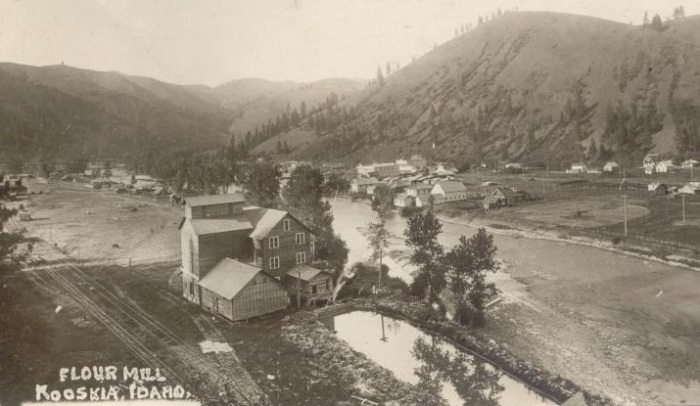
The development of this tramway marked the development in the growth of Lowe. A warehouse was constructed, one in Lowe and one in Kooska, they had the combined capacity of holding approximately 100,000 bushels of grain.
With all this economic growth, the good folks of Lowe did not seem to mind the fact their fair village was a “dry town.” Water had to be hauled some distance. After attempting to dig a well, by hand, and coming up “dry,” a purse was collected for a well drill. After going down a depth of 347 feet, water was struck. A windmill was immediately installed along with an overhead water tank.

Lowe was a thriving community; a dairy went into production selling milk and butter.
Dr. Busey, originally from Harpster, set up as a druggist and physician. The Idaho Outfitting Company, owned by J.S. Adair, was the largest implement business in the region. Mr. Adaire expanded his business from Kooskia to Lowe as he saw a great potential for growth coming from the community. Mr. Adair built a large warehouse to hold his stock and carried everything from hardware and implements to first-class, handmade workhorse harnesses.

Soon the need for the post office was addressed. With the increase of inhabitants, mail was being delayed by being sent to Lane, Idaho. The community of Lowe contacted the postal inspector, and he made a site visit. The postal inspector approved the establishment of a post office with the stipulation that it could not be named Dan Day as they did not want any more double names. Mrs. McBoyle thought it would be appropriate to name to post office an Indian name since the name Nez Perce was already taken. She used the word “Winona.” This came from an Indian Tribe in Minnesota. The government accepted the name. By 1898 Lowe had an established post office After the establishment of the post office with the name of Winona; people began referring to Lowe as Winona. The town’s original name faded into history.
While doing more research, it was discovered that the Winona area had two schools; Winona and Hopewell. Until the building of an actual schoolhouse, the school was held in the attic of the store around 1902-1903. To the best of our research, it appears that Hopewell was the first schoolhouse, located approximately four miles to the south of town. This building burnt in 1917. A new building was erected in 1918 on the hillside south of Winona near Mr. Zion Church.

The Winona school was located about 12 miles southwest of Kamiah and near the top of Seven-Mile Grade. Build in 1918, the school remained in operation until it burnt approximately 1920-1930. At that time a new building was constructed on Thorn Springs Road about a half mile from the town of Winona. School District records indicate that Winona and Kamiah combined in 1943-1944. This building was then moved to Kamiah. Kenneth Yates, a former Winona teacher from 1939-1940, moved the school building to the south end of Main Street and Tenth where it became a Baptist Church.
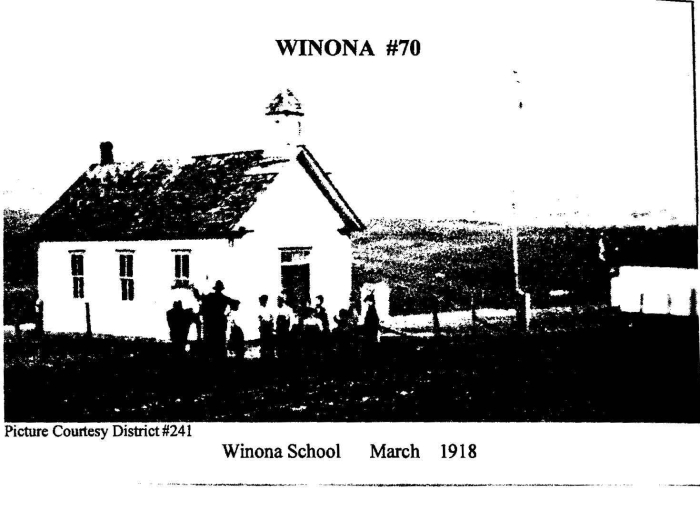


By 1909 the railroad was established to the prairie. The tramway began to lose popularity. By 1939 is was it was discontinued as the highways to Cottonwood, Grangeville, and Kamiah made the tram obsolete. Having gained importance in its heyday, Idaho maps designated the spot as “Tramway.” The area was never a town; just a boarding house and a saloon to provide for the workers. In 1940 it was completely dismantled. It is said that a truckload of the Kooskia Tramway cable left Kooskia in 1941 headed to the Idaho Hide & Junk Company in Lewiston Idaho. Another piece of our local history fades into obscurity.
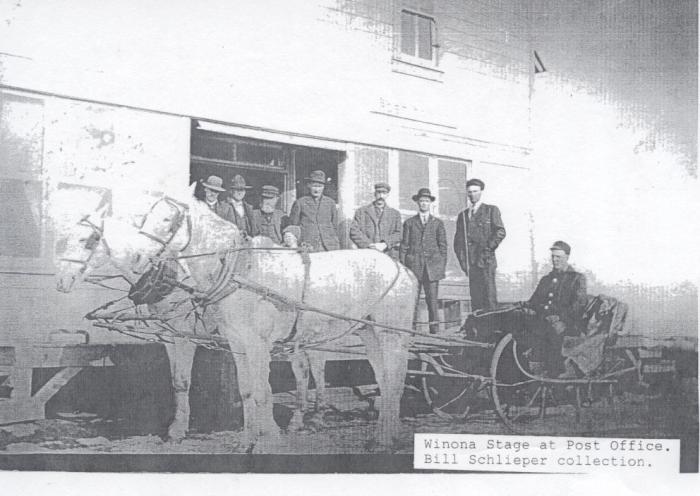
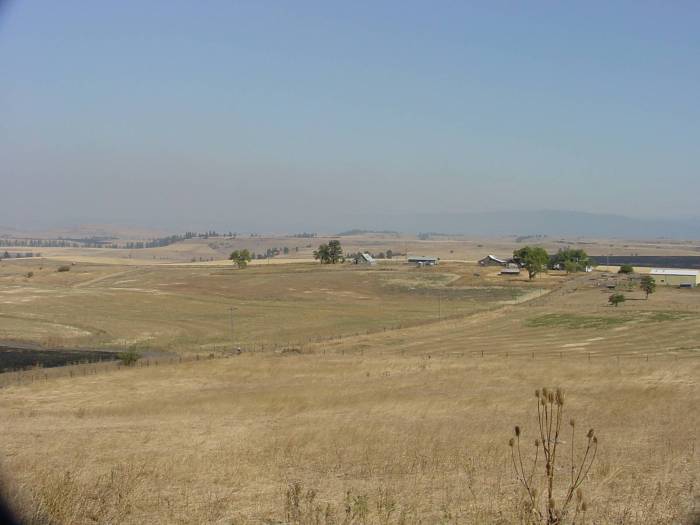
In 1943 the town of Winona was nothing more than a local berg; post office, a school with an eight-month term, and a shuttered storefront. The blacksmith shop was used for a road commissioner’s office, and a machine shed. The store was sold for the lumber, dismantled and taken to Greencreek. In August 1945 the post office was closed, and this brought an end to Winona’s historical heyday.
We hope you enjoyed reading more about one of the area’s long forgotten towns that played a significant roll in the development of the region as we know it today. Winona has always held a fascination for me, as this was where my Grandfather and his family farmed during the 1920’s. He talked about riding horseback to school in the winter when the wind would whip the snow around his horse like he was inside a snow-globe.

 Happy Trails – – – – – – Dusty Windshield
Happy Trails – – – – – – Dusty Windshield
References:
Kamiah Historical Museum – Photos
Pioneer Days in Idaho County – Sister M. Alfreda Elsensohn
Pioneer Schools of Idaho County – Kamiah, Kooskia, Stites, Idaho Retired Teachers Association
Very interesting.
LikeLike
This was neat to read! My dad’s family lived in Winona. Although he was born in Clarkston, Winona was his hometown. He didn’t talk about it much at all! Thank you for sharing.
LikeLike
I enjoyed the history lesson. I grew up on a wheat farm a short distance from Winona. I can remember a Sunday drive through there with my parents when i was young.
Thanks for sharing.
LikeLike
My dad, Earl Sapp was born in 1921 in Winona .
LikeLike
My great grandparents were early homesteaders very near Winona, within sight, I think. Claus Henry and Caroline (Lage) Mundt, married in 1883, arrived in Lewiston from Iowa February 1897 with children Arthur (Della), Annie (Charles Spangler), John (Myrtle Howard), Herman (Opal Ingram), and William (Viola Kilmer). Berta Ella (Karl Kilmer), Carl (Dorothy Jessie), Minna (Floyd Myers) (my grandmother), Rose (Bill Phillips) and Walter (Tom) (Jeanette Sales) were born after the Mundt family established their home near Winona. Claus Henry and Caroline are buried at Mt Zion cemetery. It is said that he was the first to raise tomatoes on the camas prairie — many of the earlier settlers believed them to be poisonous. He planted many fruit trees –apples, pears, cherries, plum, some of which he grafted on their homestead. Sometimes Indians would attempt to raid their garden or attempt to steal their cattle.
LikeLike
Thank you for sharing your families history about Winona! This is what I really wanted to accomplish with my blog, getting folks to share their stories about the local history. Again, thank you so much for contributing!
LikeLike
Interesting, does anyone know the fate or fortune of my old friend “Pepper Davis”. I am Bill Robinson and we joined the Navy Together in 1963.
LikeLike
The name is not familiar to me – if I should run across someone that might have known the gentleman I will pass your email address along
LikeLike
Is that a typo error with the church named Mr. Zion? Maybe it was Mt. Zion? Sounds like it would make more sense. Here’s a copy and paste from the place I read that. This building burnt in 1917. A new building was erected in 1918 on the hillside south of Winona near Mr. Zion Church.
Nice article. Mark
LikeLike
Thanks for the catch! No, it should have read Mt. Zion. Have a new laptop and the keyboard is not that user-friendly. I grew up typing on IBM Selectric typewriters!
LikeLike
Are you active on this? I am hoping I may have led myself to someone who can help me find info on a William Burns, from Lowe, Idaho. in 1905 he married a Jennie Pangborn. Jennie was my great great grandmother. I am just trying to fill in some blanks. Thanks. Diana Baldwin Hamby
LikeLike
I have not been active on the site since COVID shut most of Idaho down. I am not family with the names that you mention. Good luck on your search
LikeLike